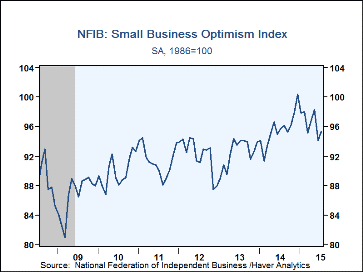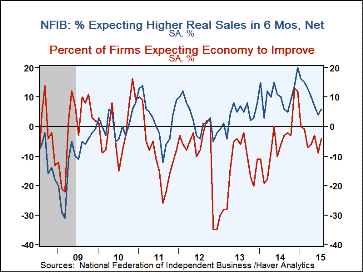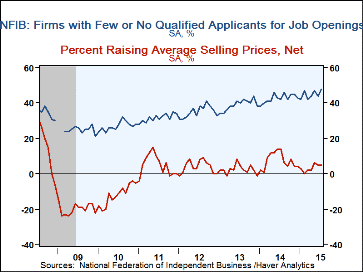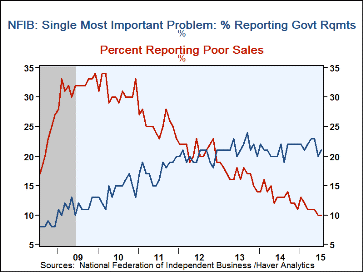 Global| Aug 11 2015
Global| Aug 11 2015U.S. Small Business Optimism Improves Moderately
by:Tom Moeller
|in:Economy in Brief
Summary
The National Federation of Independent Business reported that its Small Business Optimism Index strengthened to 95.4 during July after falling to an unrevised decline to 94.1 in June. The reading was the lowest since September of last [...]
The National Federation of Independent Business reported that its Small Business Optimism Index strengthened to 95.4 during July after falling to an unrevised decline to 94.1 in June. The reading was the lowest since September of last year.
The percentage of firms expecting the economy to improve recovered slightly to -4 but remained down from the November high of +13%. The percentage of firms expecting higher real sales in six months (6%) also was down from 16% six months ago. Twelve percent of firms were looking to increase employment, up from the 9% June low. Discouragement about the labor supply continued as the percent with positions not able to be filled right now rose slightly to 25% but the percentage with few or no qualified applicants for job positions increased to 48%, the most since September 2007. The percentage indicating now was a good time to expand the business rebounded modestly to 12%, near the middle of the range during the last year.
The percentage indicating that credit was harder to get remained at 4%, but was down from the 2009 high of 16%. The percentage planning capital expenditures in the next 3 to 6 months notched up to 24% but still was down from 29% in December.
On the pricing front, 5% of firms were raising average selling prices last month, down from 14% twelve months ago. The percentage planning price increases eased m/m to 17%. Labor's pricing power stabilized m/m as the percentage of firms raising worker compensation rose to 23% and recovered a bit of June's decline. The percentage planning to raise compensation rebounded to 15%, the most this year.
The most important problems faced by small business were taxes (22%), government requirements (21%), quality of labor (13%), poor sales (10%), insurance cost & availability (8%), competition from large businesses (8%), cost of labor (6%), inflation (3%) and financial & interest rates (2%).
Roughly 24 million small businesses exist in the U.S. and they create 80% of all new jobs. The typical NFIB member employs 10 people and reports gross sales of about $500,000 a year. The NFIB figures can be found in Haver's SURVEYS database.
| National Federation of Independent Business | Jul | Jun | May | Jul '14 | 2014 | 2013 | 2012 |
|---|---|---|---|---|---|---|---|
| Small Business Optimism Index (SA, 1986=100) | 95.4 | 94.1 | 98.3 | 95.7 | 95.6 | 92.4 | 92.2 |
| Firms Expecting Higher Real Sales In Six Months (SA, Net %) | 6 | 4 | 7 | 10 | 11 | 4 | 2 |
| Firms Expecting Economy To Improve (SA, Net %) | -4 | -9 | -3 | -10 | -5 | -15 | -9 |
| Firms Planning to Increase Employment (SA, Net %) | 12 | 9 | 12 | 13 | 10 | 6 | 4 |
| Firms With Few or No Qualified Applicants For Job Openings (SA, %) | 48 | 44 | 47 | 42 | 43 | 39 | 35 |
| Firms Reporting That Credit Was Harder To Get (SA, Net %) | 4 | 4 | 3 | 5 | 6 | 6 | 8 |
| Firms Raising Average Selling Prices (SA, Net %) | 5 | 5 | 6 | 14 | 8 | 2 | 4 |
Tom Moeller
AuthorMore in Author Profile »Prior to joining Haver Analytics in 2000, Mr. Moeller worked as the Economist at Chancellor Capital Management from 1985 to 1999. There, he developed comprehensive economic forecasts and interpreted economic data for equity and fixed income portfolio managers. Also at Chancellor, Mr. Moeller worked as an equity analyst and was responsible for researching and rating companies in the economically sensitive automobile and housing industries for investment in Chancellor’s equity portfolio. Prior to joining Chancellor, Mr. Moeller was an Economist at Citibank from 1979 to 1984. He also analyzed pricing behavior in the metals industry for the Council on Wage and Price Stability in Washington, D.C. In 1999, Mr. Moeller received the award for most accurate forecast from the Forecasters' Club of New York. From 1990 to 1992 he was President of the New York Association for Business Economists. Mr. Moeller earned an M.B.A. in Finance from Fordham University, where he graduated in 1987. He holds a Bachelor of Arts in Economics from George Washington University.










